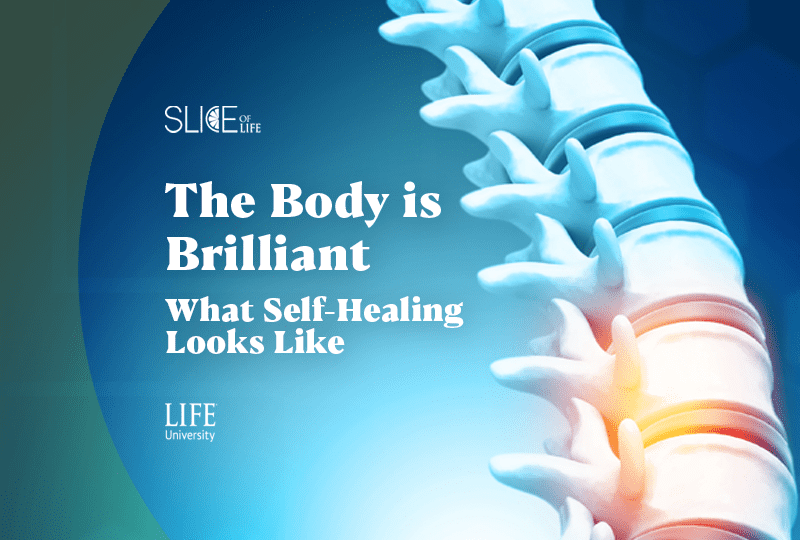Here at Life University (Life U), it is common for students and faculty to get used to hearing and throwing around terms such as Vitalism and self-healing, but occasionally it can be easy to forget that these life-changing healthcare concepts are not necessarily public knowledge to the rest of the world. If you are new to the Life U community or simply interested in learning more about what Vitalism and self-healing looks like, this article will serve as a solid introduction.
Vitalism
Life U’s passion and commitment to a vitalistic paradigm sets us apart from other universities. It is the founding tenant of Life U’s educational and clinical philosophy. Especially for students enrolled in our chiropractic program, the vitalistic ethos of Life U is a refrain that will live in your consciousness rent-free due to its intentional repetition. Vitalism is our recognition that the Universe itself is self-conscious, and as such, creates itself as a dynamic system wherein living organisms are self-developing, self-maintaining and self-healing.
Our Vitalistic Ethos – We acknowledge that the phenomenon of life is fundamentally original, adaptable and unpredictable. It is original in that life creates its own meaning; adaptable in that it expresses itself through overcoming entropy; and unpredictable as it transforms itself and evolves.
Vitalism can take many forms, and Life U offers several classes dedicated to the plentiful implications of this philosophy. For the time being, let’s explore one awe-inspiring aspect of Vitalism that can be most simply observed: Self-Healing.
How the Body Can Heal Itself
Self-healing is a phenomenon that can be observed in our bodies and in nature in uncountable ways. It can also be a bit confusing in the sense that though the body heals itself, there are things that individuals and licensed professionals such as chiropractors can do to help remove interferences that might interrupt that process.
One easy way to watch self-healing at work is by watching how wounds heal. In the busyness of our lives, we don’t always take the time to appreciate or think about the everyday miracle that is wound healing. You get a paper cut, you slap a band-aid on it and move on with your day. Yet, our bodies begin a beautiful array of tasks to jumpstart the healing process, from the littlest papercuts to the most gruesome gashes. Johns Hopkins Medicine reminds of the riveting wound healing process in their article “How Wounds Heal.”
The first step is to stop the bleeding, scientifically known as hemostasis. Within seconds or minutes of the injury, blood cells begin to clump together to form clots, protecting the wound and preventing more blood loss. Sometimes, the clots turn to scabs after drying. Clots are created by platelets and a protein called fibrin, which forms a kind of net to ensure the clot stays in place.
The next step in the process involves inflammation. Once the wound has clotted, the blood vessels open up a bit to allow fresh nutrients and oxygen into the wound to aid the healing. Blood-borne oxygen is a must. The proper balance of oxygen is also essential, because too little or too much results in a wound that doesn’t heal correctly. White blood cells called Macrophages protect the wound, fighting infection. Clear fluid on or around the cut may be visible. This is a good sign, as it helps clean out the wound. Macrophages also produce growth factors – chemical messengers that help repair the wound.
The third phase focuses on growth and rebuilding. Blood cells, including heavily oxygenated red blood cells, arrive to help build new tissue. Chemical signals tell cells to create collagen, which becomes a type of scaffolding in the body. Other tissues begin the repair process. Sometimes we can see this process at work when a scar first appears red and then dulls over time.
The final phase is strengthening. The new tissue grows stronger over time. Stretching, itching or even puckering may be observed on the wounds. Typically within three months, the wound is almost as strong as it was before the initial injury; however, depending on severity, the full healing process might take a few years to complete.
There are many other ways that the body heals itself, from its restorative processes through sleep to healing through meditation and breathing. Take the time today to thank your body for taking such good care of your health and well-being.
Slice of LIFE is an invitation to and extension of everything happening at Life University. Whether you are a current student, a potential freshman or a proud alum, Slice of LIFE can help keep you connected to your academic community. Know of a compelling Life U story to be shared, such as a riveting project, innovative group or something similar? Let us know by emailing Marketing@life.edu.
Interested in health and wellness? Learn about Life U’s Associate of Science in Health and Wellness.


Social Media